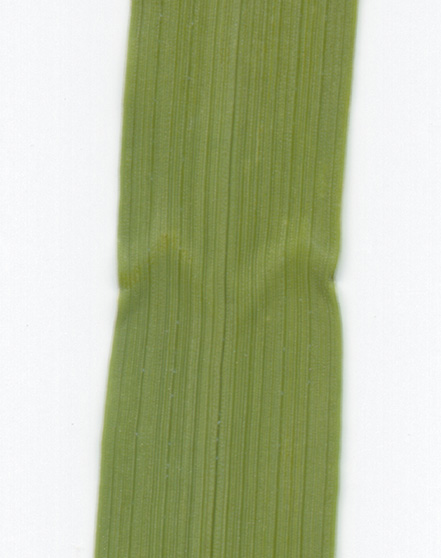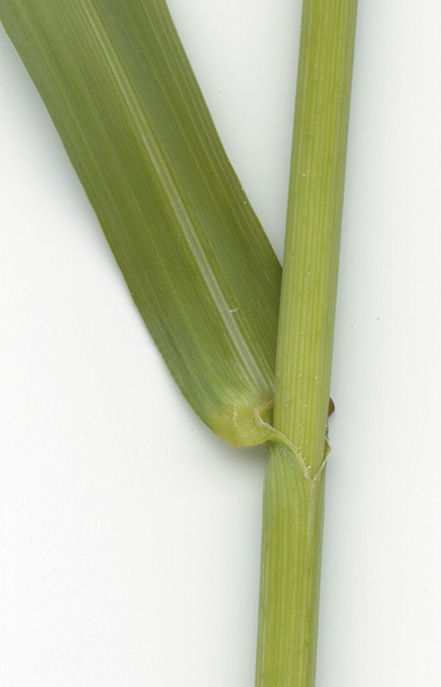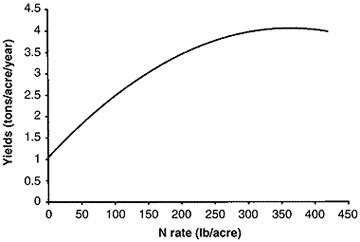
Smooth bromegrass (Bromus inermis) is a coolseason, sod-forming perennial grass introduced to the United States from Hungary in 1884. It was widely adopted in the upper half of North America and has shown exceptional drought resistance and winter hardiness. Smooth bromegrass is still used today for hay, pasture, silage and erosion control purposes.
Identification and growth characteristics
Smooth bromegrass typically grows between 15 and 36 inches tall and flowers in late spring to early summer with an open panicle (Figure 1). One of its most identifiable features is the M-shaped watermark located midway between the leaf collar and tip (Figures 2 and 3). It spreads both by seeds and rhizomes, establishing itself quickly and becoming highly competitive once a stand is formed (Figure 4).
Adaptation and use in Missouri

Smooth bromegrass performs particularly well in northern Missouri. It prefers deep, well-drained silt loam or clay loam soils but can also establish on lighter, sandier soils. The ideal soil pH is 5.5 or higher. Its winter hardiness is excellent, and its deep root system contributes to strong drought tolerance. Producers use smooth bromegrass for a variety of purposes, including hay, pasture, silage, erosion control, and as part of mixed stands with legumes like alfalfa.
Forage nutritive value
Smooth bromegrass provides high-quality forage, often exceeding 12% crude protein when harvested in the boot stage. Typically, it is more palatable and offers better nutritional value than tall fescue or orchardgrass cut at the same time of year. However, its quality declines rapidly if harvest is delayed beyond heading and becomes nutritionally inadequate by the dough stage.
Establishment

Successful establishment of smooth bromegrass requires thoughtful planning and attention to detail. The recommended seeding rate is 10 to 15 pounds per acre for a pure stand or about 10 pounds per acre when mixed with legumes. For specific seeding mixtures that include smooth bromegrass, refer to MU Extension publication G4652, Seeding Rates, Dates and Depths for Common Missouri Forages.
Although smooth bromegrass can be seeded between late February and early April, September is generally the preferred planting window in Missouri. Fall plantings benefit from reduced weed competition and have more time to develop a strong root system before facing summer stress the following year.
Few improved cultivars of smooth bromegrass are commercially available. As a result, most plantings in Missouri use common or variety-not-stated seed.
Seeds should be planted ¼ to ½ inch deep in a clean, firm, and weed-free seedbed. Many producers opt for no-till seeding to minimize erosion and protect soil structure during establishment. Regardless of the method, it is essential to ensure that the drill places the seed at the correct depth and that press wheels or other packing mechanisms ensure good seed-to-soil contact. Taking the time to properly calibrate equipment always makes a significant difference in stand success.

Smooth bromegrass seed is light and chaffy, making it sometimes difficult to handle with the fluted feeds and agitators on standard drills. Drills designed for native grasses work best, particularly those with picker wheel or saw-tooth seed metering mechanisms. It’s also important to maintain agitation in the seedbox to prevent bridging and ensure consistent seed flow during planting.
Proper fertility at planting is critical. Apply 30 to 40 pounds of nitrogen per acre at planting; follow MU soil test recommendations to address any pH, phosphorus or potassium deficiencies Ideally, any severe pH, phosphorus and/or potassium deficiencies would be addressed six months or more before seeding.
Fertility and soil management

To avoid becoming sod-bound, smooth bromegrass requires nitrogen fertilization. Although it responds positively to nitrogen rates up to 275 pounds per acre per year, the most economical yield response occurs between 80 and 140 pounds per acre (Figure 5). Nitrogen should be applied primarily in the spring, with rates of 40 to 80 pounds per acre common in Missouri. Add an additional 40 to 60 pounds per acre in late August or early September if the stand will be grazed in autumn. Over-application should be avoided to prevent lodging, grass tetany, or nitrate toxicity. A soil test should be taken at least every three years to monitor nutrient status to guide lime, phosphorus and potassium applications.
Cutting and grazing management
Smooth bromegrass should be cut for hay between early heading and full bloom, which generally occurs around mid-May. Cutting or grazing below a height of four inches significantly reduces the plant’s regrowth potential. In the fall, light grazing or haying is acceptable if a 6-inch stubble is maintained to support winter survival. The grass does not recover well from poorly timed cutting or grazing, especially during stem elongation or heading when tiller apices are vulnerable. Summer grazing must be carefully managed to avoid overuse. A rotational stocking system helps maximize both forage utilization and stand longevity of smooth bromegrass. Shifting livestock to a warm-season forage for summer use — when smooth bromegrass growth slows — prevents overgrazing and helps maintain livestock productivity.
Mixtures with legumes
When mixed with legumes such as alfalfa or red clover, smooth bromegrass offers improved forage quality and better animal performance. However, it tends to be less persistent in these mixtures compared to other grasses like orchardgrass. This is largely due to management practices that prioritize alfalfa or red clover quality, such as early or short clipping, which can remove the growing points of smooth bromegrass. Adjusting cutting height and timing can help mitigate these persistence challenges.
Weed and residue management
Maintaining a dense, healthy stand of smooth bromegrass is the most effective way to suppress weeds. Competitive stands, combined with timely fertilization and proper harvest management, minimize weed encroachment. Several herbicides are registered for use on smooth bromegrass. See MU Extension publication IPM1031, Weed and Brush Control for Forages, Pastures and Noncropland for specific weed control recommendations. Roadsides and field borders should be mowed to reduce invasive seed spread. In seed production fields, burning postharvest residue may help control problem weeds such as musk thistle and johnsongrass.
Seed production
Smooth bromegrass can also be grown for seed, typically yielding between 200 and 600 pounds per acre under normal conditions and up to 1,000 pounds per acre in ideal situations. Seed should be harvested when the stem just below the seed head has dried and matured, ideally on days when humidity is below 50%. After harvest, seed should be well aerated or turned daily to prevent overheating. The remaining stubble can be harvested as well, though it is significantly lower in nutritional value than earlier-season hay. As with forage production, nitrogen fertilization helps maintain seed yield in older stands.
Summary
Smooth bromegrass remains one of the most valuable cool-season forages for Missouri and much of the northern United States. Its strong drought resistance, winter hardiness, and high forage quality make it suitable for a wide range of agricultural uses. However, it demands careful management. Avoiding overgrazing, optimizing nitrogen fertilization, and harvesting at the correct growth stage are critical to maintaining stand productivity. When used in combination with legumes or rotational grazing systems, smooth bromegrass can support sustainable and profitable forage production.
References
Kallenbach, R. L., & Bishop-Hurley, G. J. 2004. A guide to the common forages and weeds of pastures (No. M169). University of Missouri Extension.
For updated soil test recommendations and cultivar options, consult your local MU Extension agronomist.